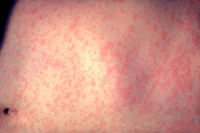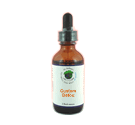 Arthropod/Vector
Bacteria
Chemicals
Fungus /Mold
/ Yeast Metals Parasites Virus Other Arthropod/Vector
Bacteria
Chemicals
Fungus /Mold
/ Yeast Metals Parasites Virus Other
|
Measles
An alternative name for measles in English-speaking countries is rubeola, which is sometimes confused with rubella (German measles). The diseases are unrelated. The classical symptoms of measles include four-day fevers and the three Cs—cough, coryza (head cold) and conjunctivitis (red eyes). The fever may reach up to 40 °C (104 °F). Koplik's spots seen inside the mouth are diagnostic for measles, but are not often seen, even in real cases of measles because they may disappear within a day of appearing. The characteristic measles rash is classically described as a generalized, maculopapular, erythematous rash that begins several days after the fever starts. It starts on the head before spreading to cover most of the body, often causing itching. The rash is said to "stain", changing color from red to dark brown before disappearing. The measles rash appears two to four days after initial symptoms and lasts up to eight days. Complications with measles are relatively common, particularly in adults that catch it. Complications can range from relatively mild diarrhea to pneumonia, Otitis media (inner ear issues), acute encephalitis (swelling of the brain), and corneal (eye) ulceration which leads to corneal scarring. NOTE: Dr. DeHaan does not believe the MMR vaccine is a healthy choice for healthy children. More >> |
|


